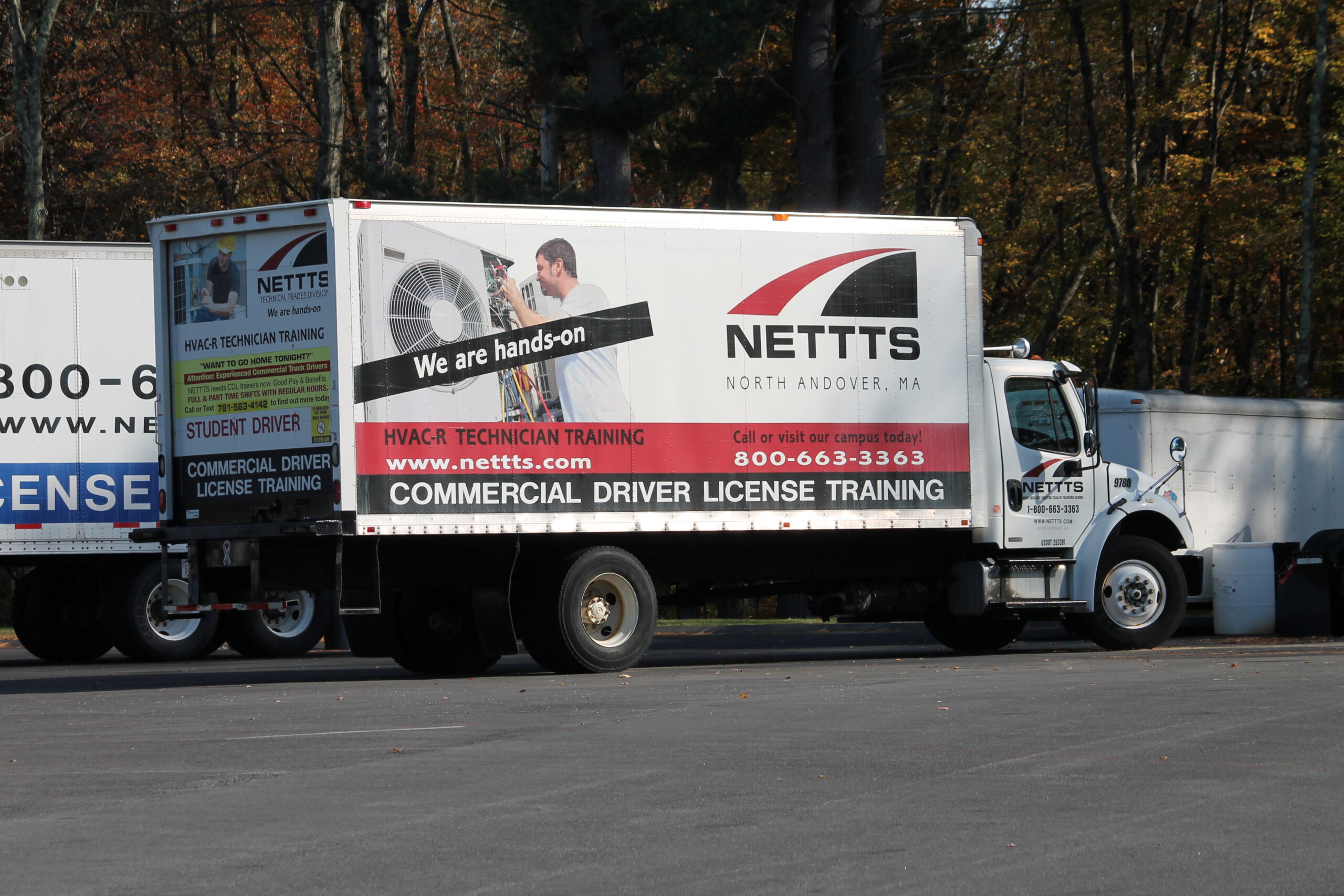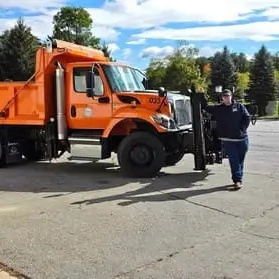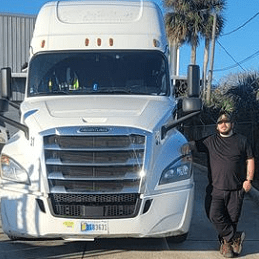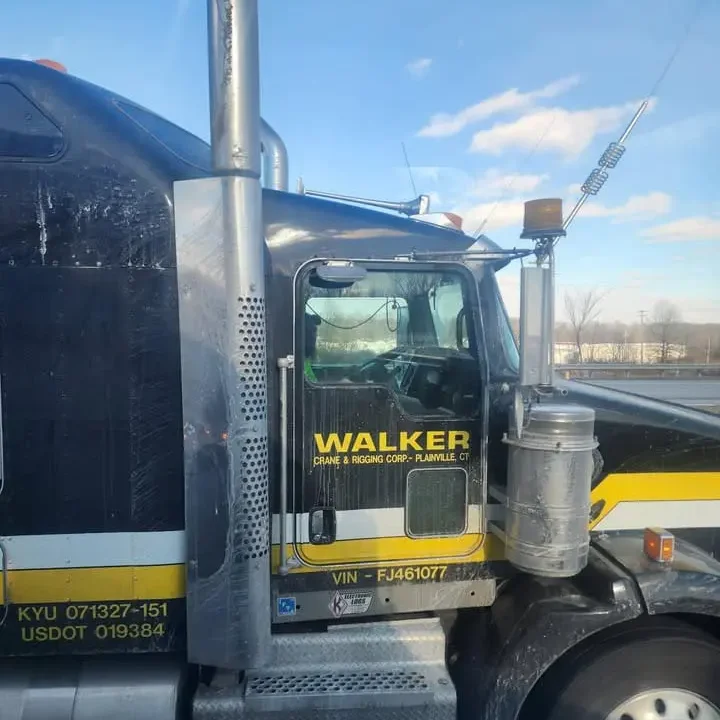Class B CDL Training School Near You In Connecticut, Massachusetts & Rhode Island
New England Tractor Trailer Training School’s (NETTTS) Class-B Commercial Driver’s License (CDL) programs include Commercial Heavy Straight Truck Training for those looking to drive a straight truck, waste removal vehicle, or dump truck. Class B is the second heaviest-weight class of commercial vehicles. Drivers in construction, waste management, and public transit (buses) can often be Class B drivers.
A Class B truck is described as:
A single vehicle with a gross vehicle weight rating/gross vehicle weight of 26,001 pounds or more
The CDL training program offered at NETTTS locations near you in Bridgeport, CT, Somers, CT, Pawtucket, RI, and North Andover, MA focuses on safely operating and maintaining Class B vehicles like:
- Straight trucks
- Dump trucks
- Box trucks
- Delivery trucks
- Segmented trucks
A Class A CDL holder is allowed to drive a Class B truck, but a Class B CDL holder cannot operate a Class A vehicle.

What Is A Class B CDL Training Program Like At NETTTS?
Training for a Class B CDL means learning the skills to drive a Class B vehicle, but also learning the rules of the road and how to safely operate this type of commercial vehicle. The program at NETTTS includes:
- CDL Learner’s Permit prep
- Prioritizing safety
- Training on federal and state regulations
- Vehicle maintenance and inspection procedures
- Hands-on and behind-the-wheel training
- Road training and CDL road test sponsorship
At NETTTS, we want you to have the time to practice and feel confident in your abilities behind the wheel. Our course combines classroom training and behind-the-wheel experience to teach you the skills for your Class B CDL road test. During training, you will be allowed to operate Class B vehicles side by side with one of our experienced instructors.
Choose NETTTS For A Class B CDL Training School Near You
Are you looking for a CDL training program? NETTTS works to make CDL training accessible to as many people as possible. Our program includes:
- Financial aid is available to those who qualify
- Career Services support
- Experienced instructors with professional driving knowledge
- A company-wide fleet of over 150 trucks and trailers for student training
- Practice on CDL driving simulator
- National Safety Council Defensive Driving Certification
- FMCSA Approved ELDT training provider
If you are ready to take the next step and find out more about our Class B-CDL program at NETTTS, we have four locations in New England where students can train, including:
- Bridgeport, Connecticut
- Somers, Connecticut
- North Andover/Haverhill, Massachusetts
- Pawtucket, Rhode Island
If you have more questions about the CDL Class-B program, contact us today to learn more or request more information.
What Our CDL Graduates Have to Say

Alex B.
CDL Graduate
North Andover, MA
Spring 2021
I needed to find my road in life. NETTTS helped me find it!*

Allen S.
CDL Graduate
Somers, CT
My experience at Somers has been phenomenal. The staff here, they all care. Shoutout to all the instructors. They’re here to guide you, answer question, and walk you through mishaps; so shout out to them. I should have started sooner!

Carlos G.
CDL Graduate
Somers, CT
Summer 2021
Coming to NETTTS was the best choice I made for my future career. I was given all the tools I needed to succeed as a CDL class A driver with my current job as a leader/trainer at Werner Enterprise.*

Derrick C.
CDL Graduate
Pawtucket, RI
Winter 2016
Going to NETTTS was the best decision I’ve ever made. Great Administration, great instructors, and just a great school all around.

Madison H.
CDL Graduate
Pawtucket, RI
Spring 2024
NETTTS gave me the tools and instruction necessary to pass my CDL test on the first try, as well as skills that I use every time I drive. I would encourage new students to ask lots of questions, because the instructors have a lot of knowledge to offer!*

Nathan D.
CDL Graduate
Somers, CT
Summer 2024
My experience at NETTTS was very good. The instructors taught me a lot in the classroom and definitely helped me learn and understand the reality of trucking. I use what they taught me every day.*

Nicole G.
CDL Graduate
Somers, CT
Spring 2014
NETTTS is so thorough with their training that I went from not knowing how to back up my own car to nearly a decade of safe driving as a trucker. Thanks to NETTTS for believing in each one of their students, no matter what their background entails.

Sue
CDL Graduate
Bridgeport, CT
I was a nurse for 30 years and decided I wanted a job I could do more on my own; more things to play with instead of people to work on. The classroom’s intense, but being in the yard is just fantastic — putting what you learned in class into action, which was great! Everybody’s taught you something that sticks with you … they’ve all been wonderful.

Tiago
CDL Graduate
Bridgeport, CT
Spring 2025
Keep trying and keep working at it and you’ll get it. Just be patient with yourself, don’t be too hard on yourself and take your time.
*Consumer information regarding current graduate employment can be found with
Graduation, Licensure, and Employment rates.
Take the First Step Towards Class-B CDL Training
CDL-B Training FAQs
Do you have more questions about NETTTS and the programs we offer? Find out answers to some of the most frequently asked questions.
How do I become a truck driver?
Whether you’re interested in a new career or looking to advance your career, if you’re interested in becoming a truck driver, find a CDL program that’s right for you. Learn more about how to become a truck driver.
What is the difference between over-the-road trucking and local trucking?
Local trucking means your routes will have you home every night. Over-the-road trucking means routes that can take you across the country and last multiple days. Learn more about over-the-road trucking and local trucking.
Can I apply for financial aid?
Financial aid is available for those who qualify. Learn more about how to apply for FAFSA for CDL training.
What is the difference between a Class A and Class B CDL?
Class A and Class B CDLs allow drivers to operate different types of vehicles. According to the Federal Motor Carrier Safety Association (FMCSA), a class A CDL is required for the operation of a combination of vehicles (such as a tractor connected to a trailer) with a gross vehicle weight of 26,001 pounds or more and a towing capacity of more than 10,000 pounds. A class B CDL is required for the operation of a single vehicle with a gross vehicle weight of 26,001 pounds or more and a towing capacity of no more than 10,000 pounds. Learn more about Class A vs. Class B CDL.



